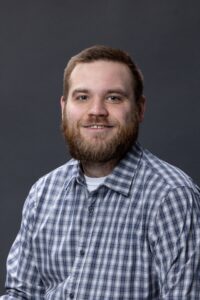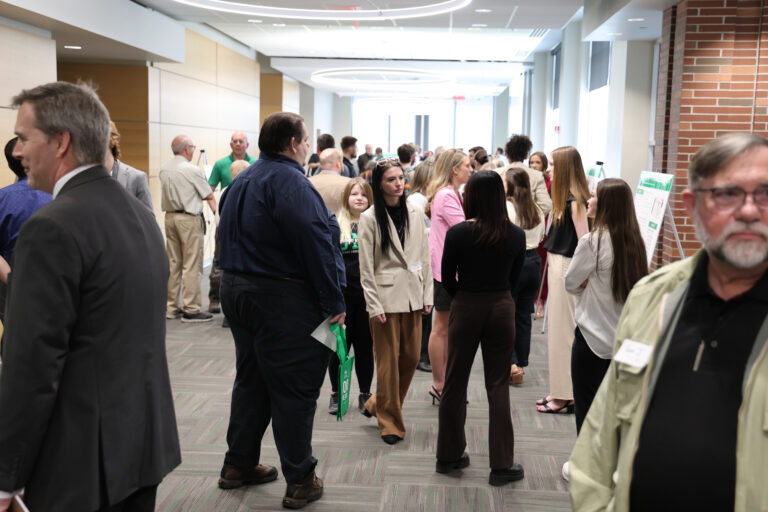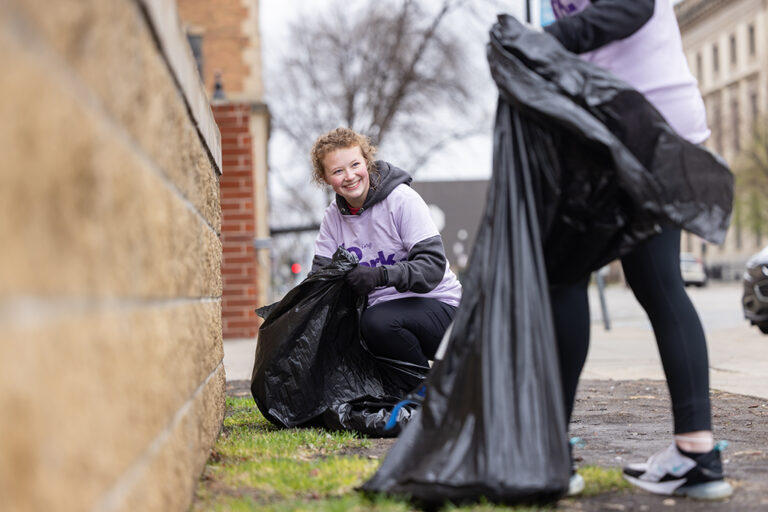A summit with substance
Actors portraying patients with addiction disorders bring intensity, realism to College of Nursing & Professional Disciplines training summit

Lyla walks into the emergency room on a Tuesday afternoon, experiencing chest pains and anxiety. She says something is wrong, and she might have a heart attack.
Lyla is visibly agitated, her eyes darting around the room, arms wrapped tightly around her body, making her smaller, less visible. As the nurse greets her, Lyla briefly scans the room and asks a concerning question, perhaps referring to her drug dealer: “Are you with him?”
As Lyla continues to panic, the nurse calmly reassures her that she is safe in his office. The tactic works and eventually she begins to match his demeanor despite being in obvious distress.
After checking her vitals, the nurse practitioner determines that Lyla was not in immediate danger of having a heart attack. He gives Lyla some medication for her anxiety and orders her a turkey sandwich from the cafeteria.
After this, he turned to three other nurses in the room and tells them that some of Lyla’s symptoms matched those typically associated with stimulant use and, after a brief discussion on next steps, the nurses compliment Lyla on her performance.
The truth is that Lyla isn’t a real person, though there are millions of people who can identify with her experience. The scenario took place in the College of Nursing and Professional Discipline’s simulation lab as a part of a day-long summit for healthcare professionals.
‘An addiction epidemic’
Hosted by the CNPD in August, the North Dakota Critical Access Hospital Summit intended to reduce the stigma of substance use disorders (SUDs) and improve patient care through informational sessions, guest speakers, and simulation lab training.
The summit was a joint effort between the Opioid Response Network (OPN), the Mountain Plains Addiction Technology Transfer Center (ATTC), and UND’s Don’t Quit the Quit program, funded through a Substance Abuse and Mental Health Services Administration (SAMHSA) grant. The focus was to train healthcare professionals at critical access hospitals (CAH).
Critical access hospital (CAH) is a designation given to medical centers in communities that meet the requirements, such as being more than 35 miles away from another hospital and having less than 25 acute care inpatient beds. These hospitals often serve communities with greater financial insecurity and fewer insured patients than hospitals in more populated areas, making them more vulnerable.
The day began with an informational session featuring College of Education and Human Development (CEHD) opioid treatment provider specialist Marvis Doster, Boston Medical Center clinical nurse educator Justin Alves, and CNPD dean Maridee Shogren. The informational session covered the need for stigma reduction and evidence-based treatment approaches in improving care for patients with SUDs.
“We are in an addiction epidemic where we’re seeing more people with alcohol problems and stimulant and opioid addictions. Stimulants in particular have grown rapidly in terms of both overdose and death,” said Justin Alves, who has participated in training nationwide as a member of the stimulant working group for ORN.

With new, more potent drugs like the synthetic opioid xylazine posing a greater risk of overdose and death to individuals with SUDs, healthcare systems nationwide are strained and struggling to provide adequate care for their patients. CAHs have felt this stress acutely with limited time and resources.
Doster, an expert trainer with the Mountain Plains ATTC, said the summit addressed a pressing issue researchers had identified in North Dakotan hospitals. A combination of expert testimonials and simulations was ideal for handling it.
“A couple of years ago, we saw a report that said that North Dakota as a whole is not great at providing support and care for folks who have a substance use disorder or are having a mental health crisis,” Doster said.
“So, we just thought that this would be a great way to bring people in to live it and experience it a little bit. Learning how to provide care is really experiential and it’s very important in caring for people with addictions.”
In this vein, Cindy Juntunen, co-director and principal investigator for the Mountain Plains ATTC and former dean of CEHD, said they hoped the organizations’ approach to the summit would have reverberating effects in North Dakotan hospitals.
“It’s becoming a crisis level epidemic and we’re really committed to making sure that rural citizens have increased access to substance abuse treatments,” said Juntunen. “We’re hoping that, by inviting healthcare professionals from rural areas and giving them access to our facilities, they can bring ideas to other providers in their hospitals and clinics.”
Practical practice with sims
Two simulations took place in the mock offices of the Nursing building’s Simulation Laboratory. One centered around Lyla, and the other revolved around a patient named Mary suffering from a mysterious jaw pain. Note that while medical simulations often use manikins as patient stand-ins, the nature of the summit called for the use of live actors to accurately portray behaviors often seen in patients with SUDs.
But even without the manikins, the simulations were remarkably realistic, thanks to the detail-oriented Sim Lab setup. To an untrained eye, these rooms are indistinguishable from actual hospital rooms, complete with hospital beds, stethoscopes, blood pressure cuffs, and computers for patient history and prescription orders.
Led by Simulation Director Ellen Steidl and the lab’s staff, the exercises were, in a word, immersive. Actors improvised scenes from outlines, responding dynamically to the world around them, which helped to provide high-level insight into how de-escalation tactics work in real-time.
Alves, who provided the scenario for the stimulant training, used his experience as a nurse working with patients with Substance Use Disorders to inform the simulations. This resulted in a great training opportunity for nurses, exposing them to appropriately high stakes situations without severe consequences.

Shogren, also the director of Don’t Quit the Quit, an grant-funded program focused on care for pregnant and postpartum individuals with substance use disorders, underscored the benefits of using immersive simulations for training, stating that they are at the “forefront of delivering high-quality nursing education.”
“This is a new type of experience for many of the attendees here today,” Shogren said. “It’s a way to experience what situations would feel like in an ER setting without the risk of what could go wrong.”
“It’s a safe place to get healthcare professionals to feel comfortable and ask questions,” she continued, “so when they find themselves in these situations back at their hospital, they have a framework for how to approach it.”
Juntunen concurred, highlighting that this summit was the first of its kind at UND to incorporate simulation training. She said the method’s engaging and flexible nature lends itself to learning about treatment of SUDs.
“Most nurses are excited to do learn and do training, and simulation labs are the natural evolution of that. Because no matter how much you sit in lectures and learn information, it’s still scary to implement training for the first time,” she said.
“I feel that we’re fortunate that the college has a good simulation center, as these just aren’t accessible everywhere,” she added. “We’re excited to be able to share our facilities with healthcare professionals like our attendees.”
Silence the stigma, give patients a voice
One of the significant problems in addressing Substance Use Disorders is that the intense stigma associated with them can impede patients from seeking help, especially in tight-knit rural areas. An essential goal of the summit was to address this issue and break down the social and psychological barriers preventing individuals from seeking treatment.
Enter Lucy Bird, the executive director of Hope’s Landing, a sober living home in Dickinson, N.D. She spoke to attendees about her experience as an individual with an SUD in small-town North Dakota, where options are limited compared to larger cities.
“I love getting to speak with people from the medical field, because sometimes that can result in some of the biggest strides in helping recovering addicts,” she said. “In the past, I’ve been to the doctor for really intense knee pain, and they’ve accused me of seeking drugs. I just feel that sometimes we lose compassion for people, and that can’t be lost if we want to help them.”
Bird emphasized the importance of increasing awareness around recovery resources like sober living homes, which can help create communal support systems while offering those in recovery autonomy and independence.
“I’d like to see people being offered resources to help them in the future, not just being pushed out the door,” she said. “I’m starting to see that more in Dickinson with Hope’s Landing, and I think we need to see more of it. We’re here, we’re a resource for you.”

During the debriefing session led by Andy McClean, chair of UND’s psychiatry department, nurses expressed how the state’s addiction epidemic had placed significant stress on their hospitals, resulting in low morale and feelings of helplessness among staff.
Despite this, multiple nurses said they found value in the summit’s content. One nurse visiting from Turtle Lake noted that the summit had rejuvenated her interest in finding different approaches to treating patients with SUDs at her CAH.
“My plan is to go back to my desk, write down my thoughts and develop a plan,” she said. “You want to strike while the iron is hot and make it compulsory. I’ll share my thoughts with the director of my hospital and let them know I think this is important.”
Addiction is a complex issue that impacts the patient’s lives, friends, family, and community. Juntunen said that the summit’s goal was to impress this concept upon the attendees and ensure better healthcare for everyone in the process.
“We’re trying to center everything on the person, not the disease,” she said. “We should treat people with substance use disorders the same way we treat people with diabetes or high blood pressure. The treatment of people with substance use disorder is just good, solid healthcare.”
****
If you’re interested in learning more about sim labs on campus, Sim Week is right around the corner. The School of Medicine and Health Sciences is holding a simulation display and open house on Sept. 18 and 19 respectively. The College of Nursing & Professional Disciplines is hosting its own simulation lab open house on the following Thursday, Sept. 21. All are welcome to attend each event.



